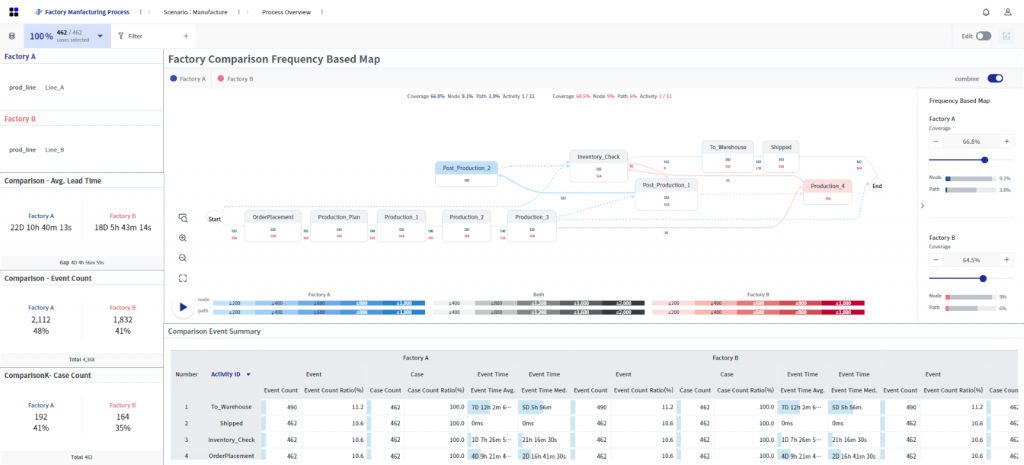BPMN Explained: Definition, Requirements & Examples
Seungho Hwang | Dec 31, 2021 | 5 min read
BPMN, or Business Process Model and Notation, is your key to streamlining operations. In this article, we delve into its versatile applications for process analysis. Learn how BPMN can transform your workflows and drive operational excellence.

What is BPMN?
BPMN (Business Process Model and Notation) can be described as a standard notation for visually modeling business processes. It can also be referred to as a specialized notation for business processes, similar to UML
.
What are the minimum requirements for BPMN?
To model business processes with BPMN, four minimum components are required.
- Event

StartEvent: The beginning of a process.
EndEvent: The end of a process.
2. Activity

Task: A normal activity or a single action that is performed as part of the process.
Loop-Task: An activity that may be repeated over and over again.
3. Connections

Sequence Flow: An arrow that connects activities to define the order in which they occur.

4. Gateway
Gateways are used to represent decision points in the process flow and include splits and joins. The use of a split gateway implies that a corresponding join gateway exists.
AND-split gateway : When splitting, all outgoing branches occur simultaneously.
AND-join gateway : When merging, it implies that all incoming paths must complete before the process can continue past the gateway.
XOR-split gateway : When splitting, the sequence flow routes to exactly one of the outgoing branches.
XOR-join gateway : When merging, it implies that exactly one of the incoming paths will have been taken, and the process proceeds with the selected path.
Example: Sarah’s Day at Work

Let’s explore an example. The diagram above represents a process model depicting Sarah’s workday.
Sarah starts her day by arriving at work (StartEvent) and attending a morning meeting (Task). At lunchtime, she encounters a crucial decision – what should she have for lunch? (XOR-split). She decides on Italian cuisine and selects both pizza and pasta (AND-split).
Following a delightful lunch (AND-join, XOR-join), Sarah spends her afternoon sending emails. As the workday’s end approaches, she confronts the choice of working overtime or leaving on time to hang out with a friend (XOR-split). Opting for the latter, she enjoys her evening with her friend (XOR-join) and heads home (EndEvent).
In this manner, BPMN serves as a valuable tool for visually representing diverse scenarios within a process.
?Note: One approach to creating a well-defined process model is to assume a single starting and ending point.
BPMN in process mining
In process mining, BPMN serves as a visual foundation for understanding, analyzing, and improving business processes. There are various methods for creating process maps. You can manually create a standard process that reflects your needs using drawing tools. Alternatively, process maps can be generated from accumulated logs in IT systems.
Now, let’s consider a scenario where you have log data for manufacturing processes in two factories, Factory A and Factory B. With ProDiscovery, you can automatically derive BPMN models and use filters to investigate the difference between the two factories.

Using the Comparison Frequency Based Map, you can visualize the processes of both factories on the same map, highlighting tasks (nodes) and flows (edges) that align or diverge. You can also compare KPIs such as average lead time, event count, and case count. Here, you can see that Factory B’s average lead time is approximately four days shorter than Factory A’s average lead time. This observation could prompt further investigation into process variants and work intensity at each factory. Eventually, you might consider developing a best practice BPMN model based on the efficient processes observed in Factory B.
Conclusion
In conclusion, the synergy between BPMN and process mining brings immense value to the world of business process management. BPMN offers a standardized and intuitive way to model processes visually, providing a common language that facilitates communication and documentation. When combined with process mining, organizations gain the power to transform these static models into dynamic, data-driven insights.
Reference
Mark von Rosing, Stephen White, Fred Cummins, Henk de Man, Business Process Model and Notation—BPMN, Editor(s): Mark von Rosing, August-Wilhelm Scheer, Henrik von Scheel, The Complete Business Process Handbook, Morgan Kaufmann, 2015, Pages 433-457, ISBN 9780127999593, https://doi.org/10.1016/B978-0-12-799959-3.00021-5.
